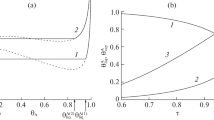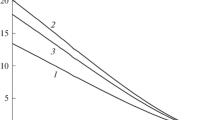Abstract
Expressions for calculating Gibbs vapor–liquid surface tension σ are generalized to allow for the interaction between comparable components of a mixture with an arbitrary radius of the interaction potential. Calculations are performed within a modified lattice gas model reflecting a discrete-continuous distribution of mixture components in space with allowance for direct correlations in a quasi-chemical approximation. The calculating of σ is associated with the rejection priority of mechanical characteristics over chemical potential, which is traditional in continuum mechanics. The chemical potential governs local equilibrium distributions of components in the transitional region of a boundary, resulting in the need to use microscopic Gibbs–Duhem equations in a deformed lattice structure of a substance to determine the average distance between molecules (as lattice structure parameters) and to consider effective one-particle motions of components in a dense phase that alter these parameters. Calculations of the surface tension of dense mixtures in models ignoring the existence of vacancies and structural deformation are discussed.
Similar content being viewed by others
REFERENCES
Physical Encyclopedy (Bol’sh. Ross. Entsiklopediya, Moscow, 1992), Vol. 3, p. 648 [in Russian].
J. W. Gibbs, Elementary Principles in Statistical Mechanics (Yale Univ., New Haven, CT, 1902; Nauka, Moscow, 1982).
S. Ono and S. Kondo, Handbuch der Physik (Springer, Berlin, 1960).
J. Rowlinson and B. Widom, Molecular Theory of Capillarity (Oxford Univ., Oxford, UK, 1978).
V. K. Semenchenko, Surface Phenomena in Metals and Alloys (Nauka, Moscow, 1957) [in Russian].
A. I. Rusanov, Phase Equilibria and Surface Phenomena (Khimiya, Leningrad, 1967) [in Russian].
A. Adamson, The Physical Chemistry of Surfaces (Wiley, New York, 1976).
Yu. K. Tovbin, Russ. J. Phys. Chem. A 92, 1045 (2018).
Yu. K. Tovbin, Russ. J. Phys. Chem. A 92, 2424 (2018).
I. Prigogine and R. Defay, Chemical Thermodynamics (Longmans Green, London, 1954).
L. D. Landau and E. M. Lifshitz, Course of Theoretical Physics, Vol. 5: Statistical Physics (Nauka, Moscow, 1964; Pergamon, Oxford, 1980).
Yu. K. Tovbin, Russ. J. Phys. Chem. A 92, 1045 (2018).
Yu. K. Tovbin, Small Systems and Fundamentals of Thermodynamics (Fizmatlit, Moscow; CRC, Boca Raton, FL, 2019).
C. N. Yang and T. D. Lee, Phys. Rev. 87, 404 (1952).
T. D. Lee and C. N. Yang, Phys. Rev. 87, 410 (1952).
K. Huang, Statistical Mechanics (Wiley, New York, 1987).
T. Hill, Statistical Mechanics; Principles and Selected Applications (Dover, New York, 1987; Inostr. Liter., Moscow, 1960).
Yu. B. Rumer and M. Sh. Ryvkin, Thermodynamics, Statistical Physics and Kinetics (Nauka, Moscow, 1977) [in Russian].
Yu. K. Tovbin, Theory of Physicochemical Processes at the Gas–Solid Interface (Nauka, Moscow, 1990; CRC, Boca Raton, FL, 1991).
Yu. K. Tovbin, The Molecular Theory of Adsorption in Porous Bodies (Fizmatlit, Moscow, 2012; CRC, Boca Raton, FL, 2017).
Yu. K. Tovbin, Russ. J. Phys. Chem. A 84, 180 (2010).
Yu. K. Tovbin, Russ. J. Phys. Chem. A 84, 1717 (2010).
Yu. K. Tovbin, Russ. J. Phys. Chem. A 90, 1439 (1999).
Yu. K. Tovbin, Russ. J. Phys. Chem. A 91, 1621 (2017).
Yu. K. Tovbin, Russ. J. Phys. Chem. A 89, 1929 (2015).
Yu. K. Tovbin, Zh. Fiz. Khim. 66, 1395 (1992).
Yu. K. Tovbin, Russ. J. Phys. Chem. A 80, 1554 (2006).
N. N. Bogolyubov, Problems of Dynamic Theory in Statistical Physics (Gostekhizdat, Moscow, 1946; Geophys. Res. Directorate, AF Cambridge Res. Labor., Air Force Res. Division, U.S.Air Force, 1960).
Yu. K. Tovbin, M. M. Senyavin, and L. K. Zhidkova, Russ. J. Phys. Chem. A 73, 245 (1999).
J. O. Hirschfelder, Ch. F. Curtiss and R. B. Bird, Molecular Theory of Gases and Liquids (New York, 1954; Inostr. Liter., Moscow, 1961).
J. E. Lane, Aust. J. Chem. 21, 827 (1968).
E. M. Piotrovskaya and N. A. Smirnova, Kolloidn. Zh. 41, 1134 (1979).
Yu. K. Tovbin, Kolloidn. Zh. 45, 707 (1983).
B. N. Okunev, V. A. Kaminskii, and Yu. K. Tovbin, Kolloidn. Zh. 47, 1110 (1985).
Yu. K. Tovbin, Russ. J. Phys. Chem. A 93, 603 (2019).
E. A. Moelwin-Hughes, Physical Chemistry (Pergamon, London, New York, Paris, 1961; Inostr. Liter., Moscow, 1962), Vol. 2.
J. Frenkel, Kinetic Theory of Liquids (Oxford Univ., London, 1946; Moscow, 1945).
C. Heer, Statistical Mechanics, Kinetic Theory, and Stochastic Processes (Elsevier, Amsterdam 1972; Mir, Moscow, 1976).
Yu. K. Tovbin, Russ. J. Phys. Chem. A 88, 1438 (2014).
I. A. Kvasnikov, Thermodynamics and Statistical Physics, Vol. 1: Theory of Equilibrium Systems: Thermodynamics (Editorial URSS, Moscow, 2002) [in Russian].
I. G. Mikhailov, V. A. Solov’ev, and Yu. P. Syrnikov, Principles of Molecular Acoustics (Nauka, Moscow, 1964) [in Russian].
R. Haase, Thermodynamics of Irreversible Processes (Addison-Wesley, Reading, MA, 1968).
A. V. Storonkin, Thermodynamics of Heterogeneous Systems (Leningrad Gos. Univ., Leningrad, 1967).
R. Kubo, Thermodynamics: An Advanced Course with Problems and Solutions (North Holland, Amsterdam 1968; Mir, Moscow, 1970).
I. P. Bazarov, Thermodynamics (Vysshaya Shkola, Moscow, 1991) [in Russian].
L. D. Landau and E. M. Lifshitz, Course of Theoretical Physics, Vol. 7: Theory of Elasticity (Nauka, Moscow, 1987; Pergamon Press, New York, 1986).
L. I. Sedov, Continuum Mechanics (Nauka, Moscow, 1970), Vol. 1 [in Russian].
Funding
This work was supported by the Russian Foundation for Basic Research, project no. 18-03-00030a.
Author information
Authors and Affiliations
Corresponding author
Additional information
Translated by L. Chernikova
Effect of Momentum and Times of Mass Relaxation on the Evolution of a System
Effect of Momentum and Times of Mass Relaxation on the Evolution of a System
Let us consider open subregion V1 of a system in which there is matter, energy, and transfer of momentum. It must be larger than Rt in order to ignore fluctuation effects [13], and smaller than total system size V (i.e., \(R_{t}^{3} < {{V}_{1}} < V\)). Two types of systems can be considered: point (spherical region) and distributed (one-dimensional along the х axis). In the first system, there is averaged relaxation to bulk equilibrium values of three state parameters: Т, Р, μ. In the second, there is relaxation of parameter distributions in a one-dimensional system. By analogy with estimates in [13, 40], in the second case we have estimates of the momentum, energy, and times of mass relaxation if the transfer coefficients for gas are replaced with similar coefficients for a fluid. For time τР of momentum relaxation, we have τР ∼ L/c, where L is a characteristic system size of ~1 cm, and с is the speed of sound in the medium; in a liquid, it exceeds the speed of sound in a gas by 300% or more [41]. For the mass relaxation time, we have τm ~ L2/6D, where coefficient D of diffusion is at least three orders of magnitude smaller than the one in a gas, which alters the ratio of characteristic relaxation times by yet another 4–5 orders of magnitude (for a gas, this ratio is 10–5–10–4). This generally results in differences of 10–8–10–10 times in the τР/τm ratio.
Relaxation is a non-equilibrium process and must be described by kinetic equations for all parameters that determine internal energy \(U = TS - PV + \mu N\), where all values have their common meaning. These equations are used for the density and pair distribution functions [19] supplemented with the equations in [13, 42] for momentum and energy transfer. We differentiate the expression for U with respect to the time:
U can be written in the form U = U1 + U2, where U1 is an internal energy component that depends only on intense parameters (T, P, μ) and U2 is an internal energy component that depends only on extensive parameters (S, V, N):
where
and
According to the Gibbs definition, the full equilibrium state is established after achieving three partial equilibria with respect to intensive parameters [2–7]: momentum, temperature, and chemical potential \(dT{\text{/}}dt = 0\), \(dP{\text{/}}dt = 0\), and \(d\mu {\text{/}}dt = 0\). They are contained in the equation \(d{{U}_{1}}{\text{/}}dt\) and correspond to the equilibrium values of intensive parameters (Т, Р, μ)е. The evolution of extensive parameters is observed in derivative \(d{{U}_{2}}{\text{/}}dt\). If the system does not undergo radical changes of properties during the non-equilibrium relaxation process (i.e., extensive variables do not go beyond their definitions), the evolution of U2 is determined by changes over time only for extensive parameters that do not affect the evolution of intensive parameters.
The complete relaxation of a system with respect to intensive parameters from some nonequilibrium state with initial parameters (Т, Р, μ)in to its equilibrium state (Т, Р, μ)е must correspond to a transition from \(d{{U}_{1}}{{(T,P,\mu )}_{{{\text{in}}}}}{\text{/}}dt \ne 0\) to the state with \(d{{U}_{1}}{{(T,P,\mu )}_{{\text{e}}}}{\text{/}}dt = 0\). Separating evolution U2 in (A1), we then obtain the equation for analyzing relations between the characteristic times for momentum, energy, and mass, which describes the relaxation of the system to full equilibrium
where relaxation times for intensive variables Т, Р, and μ are formally introduced. Each type of the transfer process can be characterized by its effective parameter transfer rate constant: momentum \(dP{\text{/}}dt\sim {{K}_{P}}\sim 1{\text{/}}{{\tau }_{P}}\), energy \(dT{\text{/}}dt\sim {{K}_{{{\text{energy}}}}}\sim 1{\text{/}}{{\tau }_{T}}\), and mass \(d\mu {\text{/}}dt\sim {{K}_{\mu }}\sim 1{\text{/}}{{\tau }_{\mu }}\). If we limit ourselves to analyzing isothermal processes (omitting the first summand in (A3)),
Experimental data [10, 11] indicate a strong difference between relaxation times of momentum and mass transfer processes \({{\tau }_{P}} \ll {{\tau }_{\mu }}\): rapid momentum relaxation formally means a rapid effective rate constant of momentum transfer. In function \(d{{U}_{1}}{\text{/}}dt\), a considerable change in local pressure occurs over times of around \({{\tau }_{P}}\) at virtually constant chemical potential μin. Due to the nonequilibrium initial state, this means there is no full equilibrium (due to a small change in μin) in times ∼\({{\tau }_{P}}\). This process governs the evolution of \(d{{U}_{1}}{\text{/}}dt\) at any initial state. With successive repetition of time steps ∼\({{\tau }_{P}}\), the state of a system also changes due to the difference in pressure with a very slow change in the chemical potential μ. Establishing full equilibrium over a long time is thus determined by the transfer of mass, and not momentum.
The effect the relaxation times of momentum and mass transfer have on the evolution of other thermodynamic potentials, which are equivalent to the internal energy in the other natural variables (Eq. (A4) also corresponds to the free energy in any isothermal relaxation process), or the evolution of thermodynamic properties obtained from thermodynamic potentials by simple differentiation can be considered similarly [43–45]. It follows that in the full equilibrium state, total local pressures must be expressed from the condition for the minimum free energy in the local volume at a matter distribution that corresponds to the condition of equality for the chemical potential in the entire system, rather than from an analysis of only mechanical stresses as in the theory of elasticity [46, 47].
Equilibrium molecular theory yields expressions for local equations of state in any point of a system, including ones inside the transitional region of an interface. These local pressures are found using microscopic Gibbs–Duhem equations [23, 24] directly related to the chemical potential of a substance. This makes redundant the Laplace equation, which is no way related to the chemical potential.
Rights and permissions
About this article
Cite this article
Tovbin, Y.K. Supplement to Calculating Vapor–Liquid Surface Tension According to Gibbs. Russ. J. Phys. Chem. 93, 1662–1671 (2019). https://doi.org/10.1134/S0036024419090280
Received:
Revised:
Accepted:
Published:
Issue Date:
DOI: https://doi.org/10.1134/S0036024419090280




